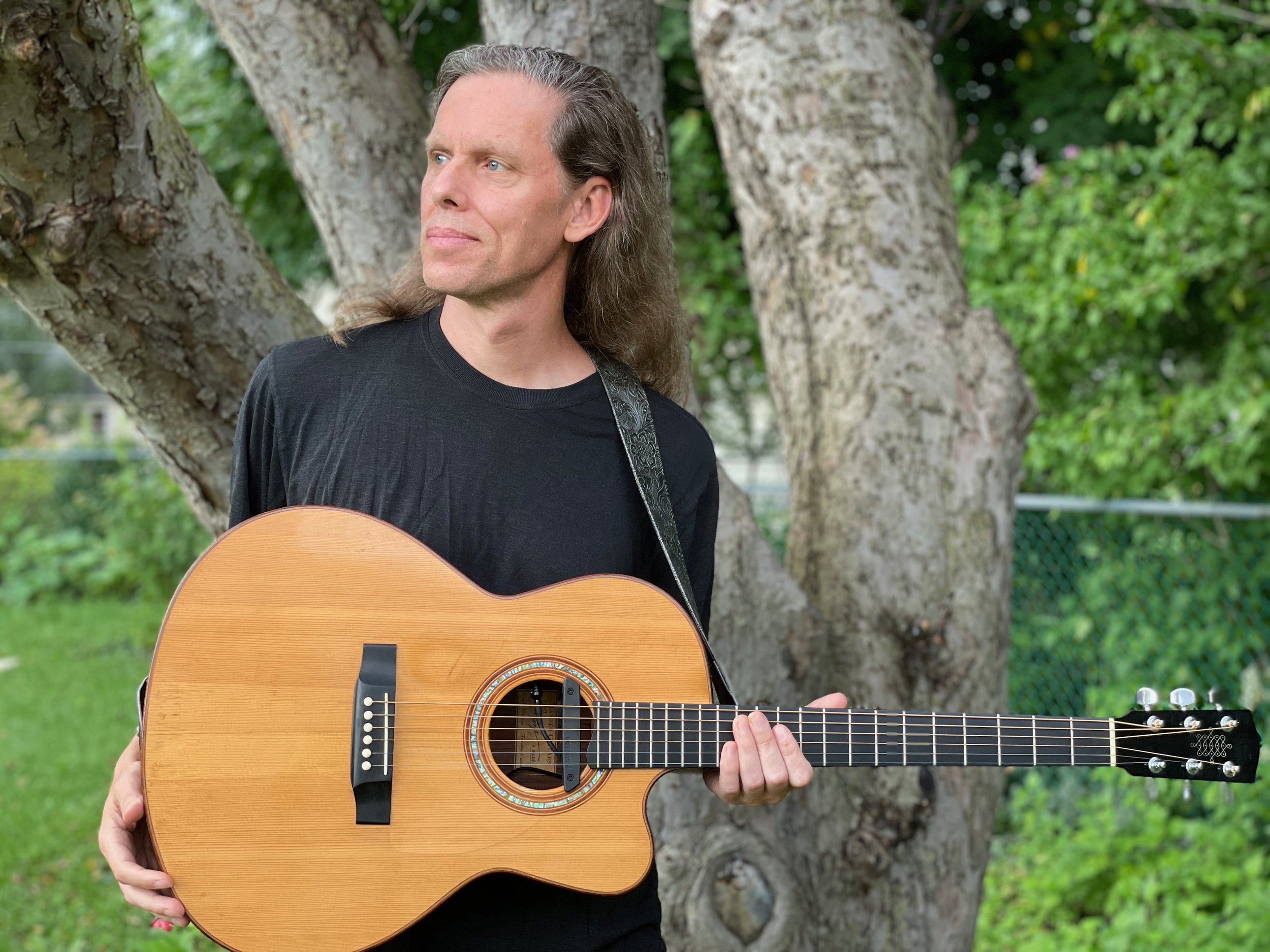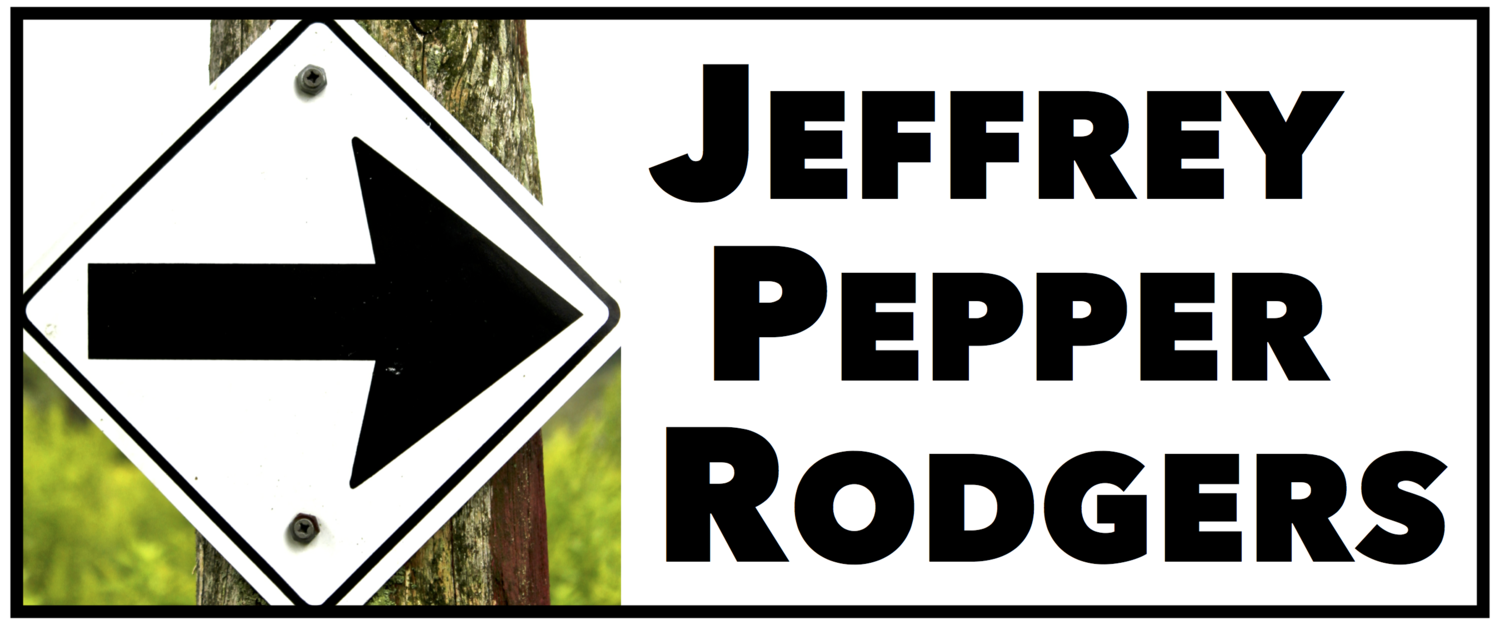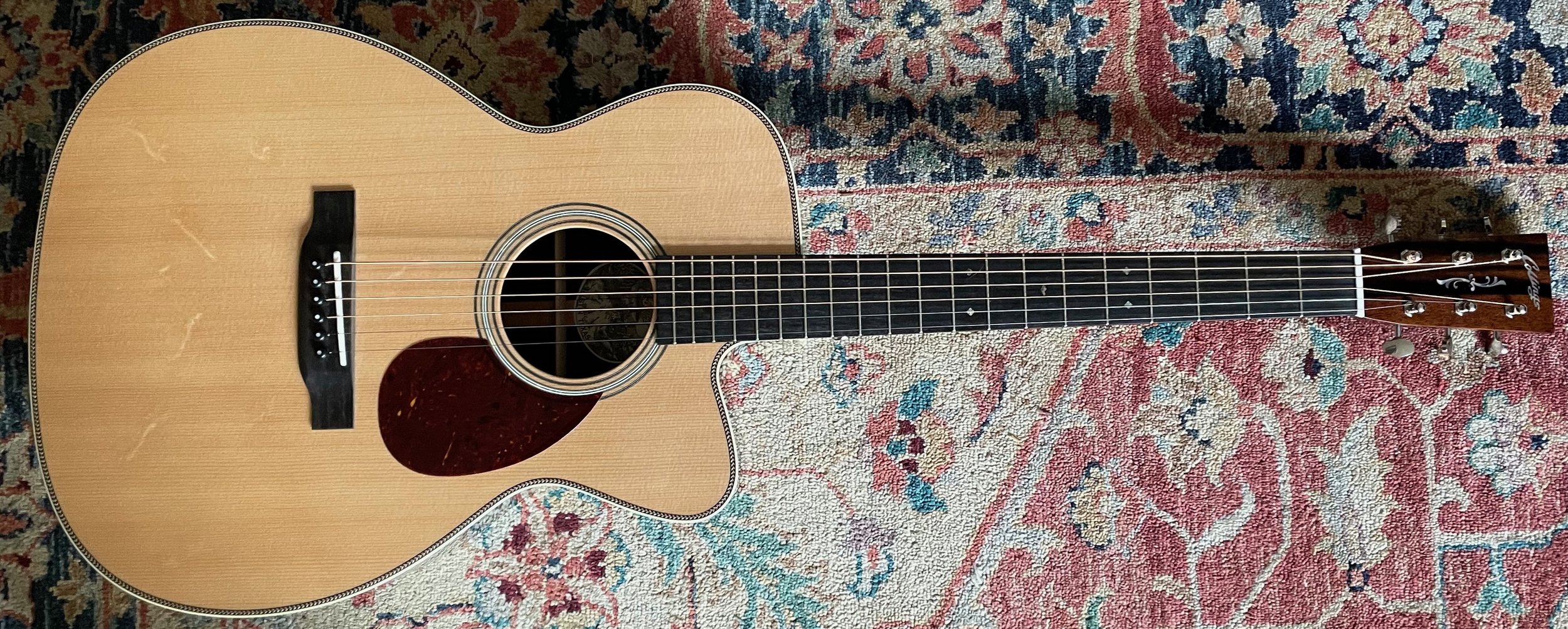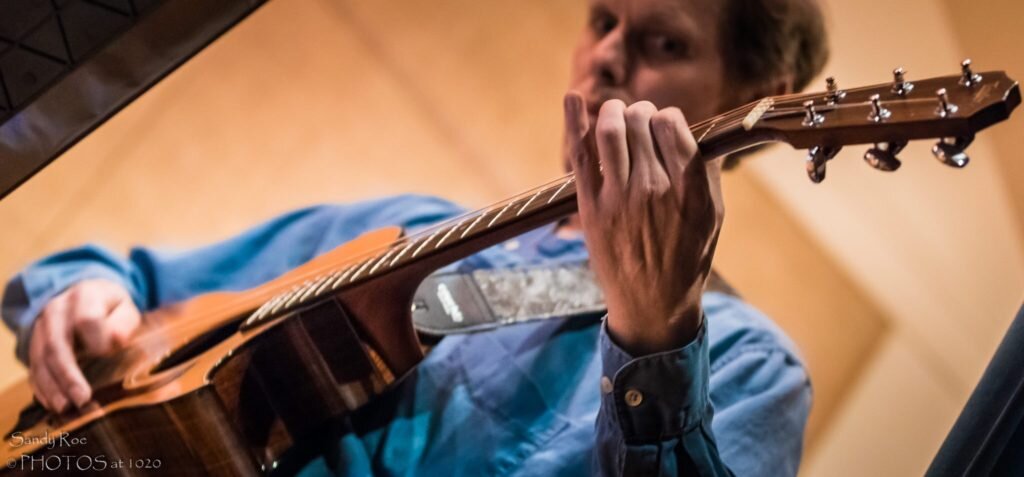
Guitars and gear
My Manzer guitar, reunited with its maker, at the Woodstock Invitational Luthiers Showcase.
Here is a rundown of the instruments and gear that I use to make music.
The list doesn’t change a lot year to year—when I find an instrument or piece of equipment that inspires me and helps me create the songs I’m imagining, I stick with it. I also like to keep things simple, especially when it comes to electronics. Lots of cool sounds can be achieved with effects and loopers and whatnot, but I prefer to focus on what I can do by hand, in real time, with strings and wood.
For a guide to the tunings (and partial capo setups) I use, head here.
Instruments
The Manzer
This steel-string guitar by Toronto-based luthier Linda Manzer, builder of instruments for Pat Metheny and Bruce Cockburn, among others, has been my main companion for writing and recording since 1999.
My guitar has a German spruce top, Indian rosewood back and sides, the Manzer wedge (the body is tapered so it’s thinner and more comfortable under your arm), and custom inlay on the headstock and fingerboard inspired by kolams, a form of Indian folk art. I spent extended time in south India and loved these beautiful symmetrical patterns that many woman make with white rice flour on their doorsteps to welcome in the day (for a related personal story, see “The Christmas Kolam”). I shared with Linda some drawings from a book of traditional kolam patterns that I’d brought home from India, and we came up with an inlay design.
Collings OM2H Cut
The latest addition to the guitar family, with an old-growth Sitka top and flourish inlay.
1990 Taylor 712-C
Performing with the Taylor 712-C. Photo by Sandy Roe.
I’ve performed and traveled extensively with this grand concert size guitar, which has the sharp Florentine cutaway that Taylor used in the early days and has revived on several models.
Strumstick
A cross between a dulcimer and a guitar, the three-stringed Strumstick is such a fun little instrument. I’ve written and recorded several songs on the Super G Strumstick (tuned G D G), including “Humming My Way Back Home” and “Eight Days in January.” I also have a larger D Grand (tuned D A D), which made its debut on the song “Holy Man.”
I get so many questions about the Strumstick when I bring it onstage that I decided to write a song introducing the instrument—as follows.
Accessories
D'Addario phosphor bronze strings
I’ve used D’Addario phosphor bronze strings forever—either EJ16 light gauge or the EJ19 bluegrass set with medium basses and light trebles. I first heard about the bluegrass set from Shawn Colvin during an interview and have found them to be a great match for my style, especially since I tune my bass strings down so often. They fatten the low end while still giving me the ease of light strings on top.
Capos
Shubb standard C1 and FineTune capos. The FineTune wraps around the neck and can stay attached on the neck (just past the nut) when not in use—a handy feature onstage.
Partial capos: Shubb C7b (covers three strings) and D’Addario/Planet Waves NS Drop Tune (covers five strings). See this page for examples of songs using partial capos.
Shubb C7b partial capo covering strings 5, 4, and 3 at the second fret.
Picks
BlueChip TD45 and Dunlop Primetone 1.3 mm flatpicks.
Tuners
I’ve owned a lot of clip-on headstock tuners, but the D’Addario Nexxus 360 is the best by far. It’s rechargeable (with extremely long battery life) and has a bright display and quick response.
For plugged-in tuning, I use an old, faithful Boss TU-2 pedal (now replaced by the TU-3).
Strap
Couch vinyl strap made in Los Angeles.
Case
Hoffee case
In addition to a hard-shell case, I use a Mono Vertigo Ultra Acoustic case, which provides substantial protection and storage but is lightweight and easy to carry and even has wheels. I also have Mono’s optional Tick case, which attaches to the Vertigo and holds my preamp/DIs and other gear.
Amplification
The Manzer and Taylor both have Fishman Rare Earth Mic Blend systems (magnetic soundhole pickup and internal mic). I sometimes use a TRS splitter cable that can send the pickup and mic output into separate channels.
The Collings has a K&K Pure Mini.
Both Strumsticks have great-sounding pickups installed by Strumstick creator Bob McNally.
For a preamp/DI, I plug into either a Grace Design BiX (especially with the K&K) or a Fishman Platinum Pro DI.
At gigs where I supply sound reinforcement, I use a Fishman SA-330 PA/amplifier in conjunction with the SA Expand (a small, lightweight box that adds four channels) and the SA Sub—I’m amazed at how much low-end richness the sub adds even if I’m not using bass or drums. For duo and band shows, I add a Fishman SA-220 and sometimes a QSC K8.2 powered speaker. I use these amps/speakers in several configurations:
Solo, with vocal and guitar straight into the SA-330’s two channels (plus there’s an aux input if needed). I place the SA-330 on the side of the stage parallel to my mic setup or, when possible, a bit further back for better monitoring.
Duo, with both Fishman amps. Each performer plugs into an amp and sends a monitor mix to the other amp (so all instruments/vocals can be heard in both amps, and the performers can adjust their own mix).
Band. I plug all the inputs into the SA-330 and SA Expand (supplemented with a Mackie ProFX12 mixer if I need more channels) and send the mix to the SA-220. For larger venues and outdoor stages, I use the 220 behind the musicians for monitoring, and the 330 plus the QSC K8.2 out front so that they can be cranked up without feedback concerns.
I love performing acoustically with a single microphone, both solo and with my duo, and often use an Audio-Technica 3060 tube condenser (no longer made) for this purpose. Here’s an article I wrote with advice on single miking. I've also recorded extensively with the 3060, especially vocals, with great results.
For vocals onstage, I currently use a Shure Beta 87a condenser. I’ve recorded many guitar tracks with a matched pair of Rode NT5 pencil condenser mics and occasionally use one of these as an instrument mic in a quiet concert setting.




